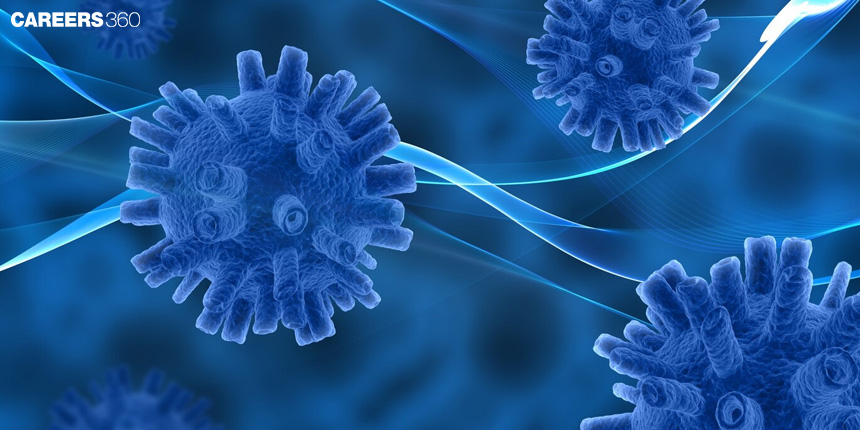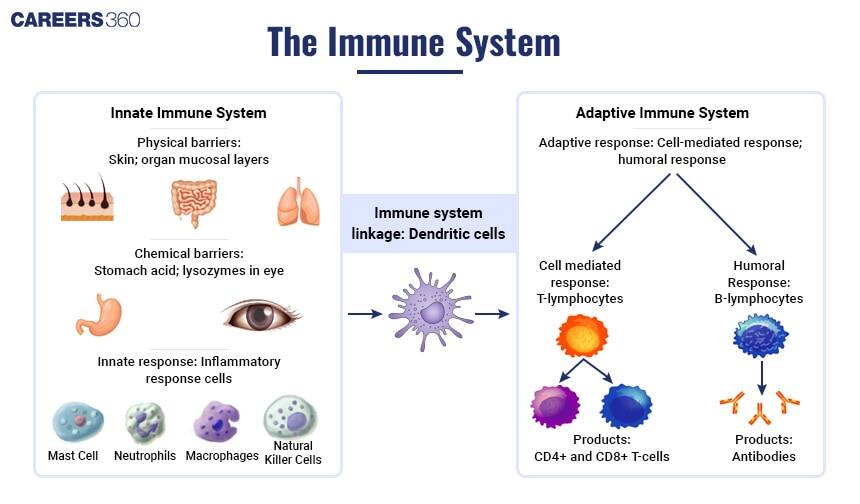Difference Between Innate and Adaptive Immunity: Points, Table, Examples
Innate and acquired immunity or two key immune responses that protect our body against diseases. Innate immunity provides a rapid, non-specific defense against pathogens which act as the body's first line of defense. Acquired immunity develops over time by creating specific responses to each pathogen and it has a memory for Quicker reaction when there is re-exposure of the pathogen. There is a difference between innate and acquired immunity that is in the response speed specificity and memory which offers long-lasting and targeted protection. This is an important part of the chapter Human Health and Diseases class 12th biology and it has good weightage in entrance exams like NEET, Paramedical and Pharmacy.
- What is immunity?
- Difference Between Adaptive Immunity and Innate Immunity
- What is Innate Immunity?
- What is Adaptive Immunity?
- Importance of Both Types of Immunity
- Tips, Tricks, and Strategies for Innate and Adaptive Immunity

What is immunity?
Immunity is a body's response to resist infections and harmful toxins which are exposed to the body through different pathogens. There are two types of responses involved which are innate and acquired immunity.
Innate immunity is an immediate nonspecific defence system that we are born with while acquired or adaptive immunity develops over time and it offers a targeted response to the pathogens which is based on a memory of the body.
The difference between innate and acquired immunity also includes response speed and specification as immunity is the first line of defence while acquired immunity is lasting specific protection from the exposure of the pathogen. Therefore it becomes important to understand the difference between innate and adaptive immunity in response to body mechanism.
Also Read:
Difference Between Adaptive Immunity and Innate Immunity
A Comparative Analysis of Innate and Adaptive Immunity is tabulated below:
Feature | Innate Immunity | Adaptive Immunity | |
Definition | The first line of defence, non-specific | The second line of defence, specific | |
Specificity | Non-specific | Highly specific | |
Memory | None | Long-lasting memory | |
Response Time | Immediate | Delayed (days to weeks) | |
Duration of Response | Short-term | Long-term | |
Major Cells Involved | Phagocytes (macrophages, neutrophils), NK cells | T cells, B cells | |
Soluble Factors | Cytokines, complement proteins | ||
Pathogen Recognition | Pathogen-associated molecular patterns (PAMPs) | Specific antigens | |
Primary Function | Immediate defence against infection | Long-term immunity and pathogen elimination | |
Examples of Responses | Inflammation, fever, phagocytosis | Antibody production, cytotoxic T-cell response | |
Evolutionary Aspect | Present in all multicellular organisms | Present only in vertebrates | |
Differences in Specificity and Memory | Non-specific, no memory | Highly specific, long-lasting memory | |
Differences in Response Time and Duration | Immediate response, short-term protection | Delayed response, long-term protection | |
Interaction Between Innate and Adaptive Immunity | Provides initial defence and signals adaptive immunity | Enhances and sustains the effectiveness of innate immunity |
Graphical Representation
Diagrammatic representation of Innate and Acquired immunity is discussed below:
What is Innate Immunity?
Non-specific immunity, also referred to as inborn or innate immunity, is the first defence mechanism of the body against pathogenic organisms. It is non-acute and is active from birth, offering an immediate response to numerous invaders without sensitisation.
Key features of innate immunity
Non-specific response: Affects any pathogen without any preference for the type of pathogen.
Immediate defence: It operates within a few minutes to a few hours of contact.
Physical and chemical barriers: It makes use of skin, mucous membranes, hydrochloric acid in the stomach, enzymes in saliva, and also in tears.
Cellular components: participate in phagocytes, macrophages, and neutrophil granulocytes, natural killer cells (NK).
Soluble factors: include cytokines and complement proteins, which play a role in pathogen killing.
Mechanisms of Action of Innate Immunity
The primary defence that innate immunity has to eradicate pathogens is through the use of different techniques, including phagocytosis, inflammation, and complement activation. For example, macrophages are the cell that engulfs and decomposes pathogens; NK cells are HCA that kill infected or cancerous cells.
Examples of innate immune responses
Some examples are skin preventing the access of pathogens, neutrophils helping in immobilization and killing of bacteria in the wound, and cytokines making the body temperature high to fight the pathogen
What is Adaptive Immunity?
The adaptive immune system, or acquired/specific immunity, is the resistance that develops in response to examples of specific pathogens. It is defined by its capacity to remember previous infections and produce enhanced immune reactions when an organism is re-exposed to pathogens.
Key features of Adaptive Immunity
Specific response: This bows specifically to antigens on pathogens.
Memory development: Recalls prior interactions with pathogens to prepare for the next meeting and respond promptly and adequately to the diseases.
Delayed onset: It takes several days to several weeks to manifest after the onset of infection.
Lymphocytes: This is the one that involves B cells and T cells.
Antibody production: The B-type cells synthesise the antibodies that neutralise the pathogens.
Mechanisms of action of Adaptive Immunity
Adaptive immunity works through two main pathways:
Humoral immunity: B cells are responsible for the production of antibodies that form an immunity coat around pathogens, thus pointing out the disease-causing agents for destruction.
Cell-mediated immunity: T cells act as direct effector cells against pathogen-infected cells or help other immune cells in moulding their response against the pathogen.
Examples of adaptive immune responses
These include the generation of antibodies when one is vaccinated and the killing of virus-infected cells by cytotoxic T cells during a viral illness.
Importance of Both Types of Immunity
It is important to note that, innate immunity responds immediately to infections, while adaptive immunity has a more detailed as well as a long-term response. Altogether they provide chemical armour around the cells.
Role in overall health and disease prevention
Artificial and natural immunity work hand in hand to help one’s body fight infections and diseases. Nurses and other healthcare workers must work together for patients’ well-being and to contain potential infections.
Tips, Tricks, and Strategies for Innate and Adaptive Immunity
It takes effort to remember everything in a single go. We made the entire problem easy. Some of the tricks regarding Innate and Adaptive immunity are given below which you can use to memorise the important points.
Innate Immunity
"PIIC: Physical, Inflammatory, Immediate, Cells"
P: Physical barriers (e.g., skin and mucous membranes)
I: Inflammatory response (e.g., redness and swelling)
I: Immediate response (non-specific, rapid action)
C: Cells involved (e.g., neutrophils, macrophages)
(This helps remember the main features of innate immunity.)
Adaptive Immunity
"MSAM: Memory, Specificity, Antibodies, Memory Cells"
M: Memory (remembers specific pathogens for faster responses)
S: Specificity (targets specific antigens)
A: Antibodies (produced by B cells to neutralize pathogens)
M: Memory cells (T and B cells retain memory of past infections)
(Captures the key characteristics of adaptive immunity.)
Types of Adaptive Immunity
"CA: Cell-Mediated, Antibody-Mediated"
C: Cell-mediated immunity (T cells target infected cells directly)
A: Antibody-mediated immunity (B cells produce antibodies)
(Differentiates the two arms of adaptive immunity.)
Key Differences Between Innate and Adaptive Immunity
"TMR: Time, Memory, Response"
T: Time (innate is immediate; adaptive takes time to develop)
M: Memory (only adaptive immunity has memory of pathogens)
R: Response (innate is non-specific; adaptive is specific)
(Summarizes main differences between innate and adaptive immunity.)
Cells in Innate and Adaptive Immunity
"PMLT: Phagocytes, Macrophages, Lymphocytes, T Cells"
P: Phagocytes (e.g., neutrophils in innate immunity)
M: Macrophages (large phagocytes in innate immunity)
L: Lymphocytes (T and B cells in adaptive immunity)
T: T Cells (adaptive immune cells targeting pathogens directly)
(Differentiates key cells between innate and adaptive immunity.)
Pathogen Recognition
"PAN: Pathogens, Antigens, Non-Specific"
P: Pathogens (foreign invaders that cause disease)
A: Antigens (unique molecules on pathogens recognized by adaptive immunity)
N: Non-specific (innate immunity doesn’t require specific antigen recognition)
(Describes how innate and adaptive immunity identify pathogens.)
Also Read
Frequently Asked Questions (FAQs)
The key difference between innate and adaptive immunity is specificity. Innate immunity is the first response of a body against pathogens and has low specificity in terms of the invader. Conventional immunity provides a general immune response as it is non-specific, a general response to all pathogens, and does not develop immunological memory for increased and quicker responses in future exposures.
Memory in adaptive immunity plays a critical role because it allows the immune system to provide quicker and more efficient responses to the pathogens that have been previously met by the body. It gives long-term immunity, is the way that vaccines work, and allows for a quicker, more robust reaction to repeated infection.
Vaccines are in a way put into the body a component or a part of a pathogen, and this leads to the production of an immune response that is tailored to combat the pathogen without having to occasion the disease. This, in a way, forms memory cells that remind the immune system of the pathogen, therefore, the body will be able to put up a quicker and better defence in the event the pathogen is encountered in the future.
Typically innate immunity does not get enhanced with time, this is because it does not have memory, unlike adaptive immunity. Nevertheless, people's innate immune response is prone to health, diet, and some variables that include exercising immunity through the use of harmless bacteria.
It needs to be understood that a lot of problems can occur when the immune system is not healthy. Autoimmune diseases are typical cases when the immune system of a human body starts attacking the cells of the same body, for example, in rheumatoid arthritis. AIDS, which is a class of subordinate immunity also known as immunodeficiency disorders, increases the susceptibility of the body to infections. Allergies are the consequences of an overreaction by the body’s immune system to substances that are harmless.
Also Read
02 Jul'25 05:59 PM
02 Jul'25 05:59 PM
02 Jul'25 05:38 PM
02 Jul'25 05:38 PM
02 Jul'25 05:36 PM
02 Jul'25 05:36 PM
02 Jul'25 05:36 PM
02 Jul'25 05:36 PM
02 Jul'25 05:36 PM

